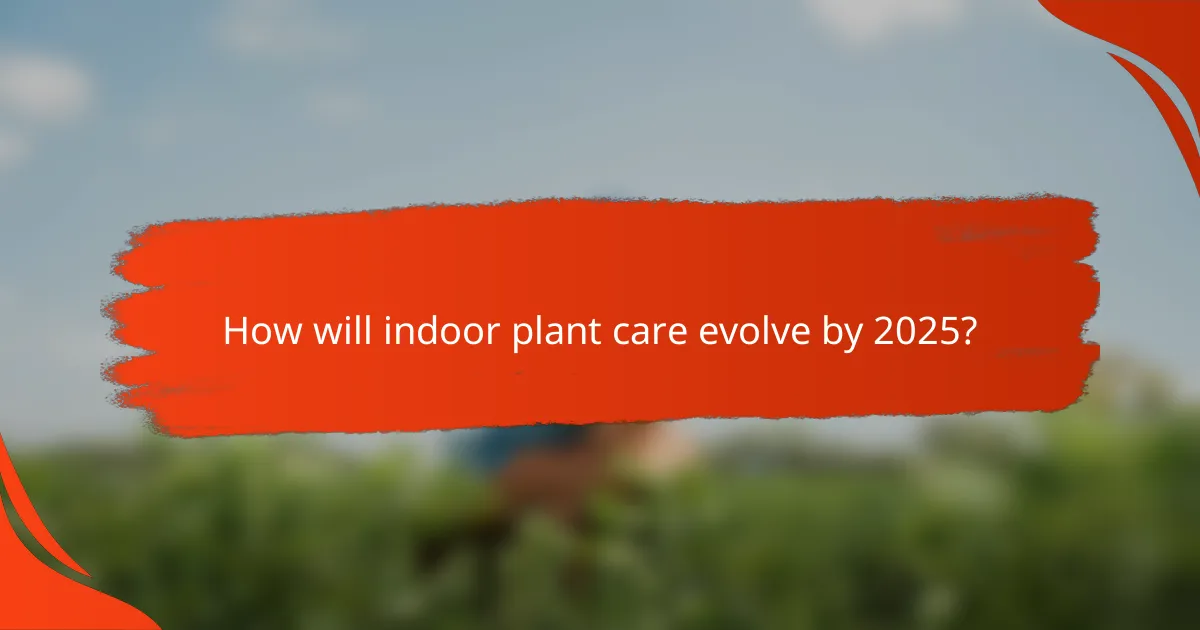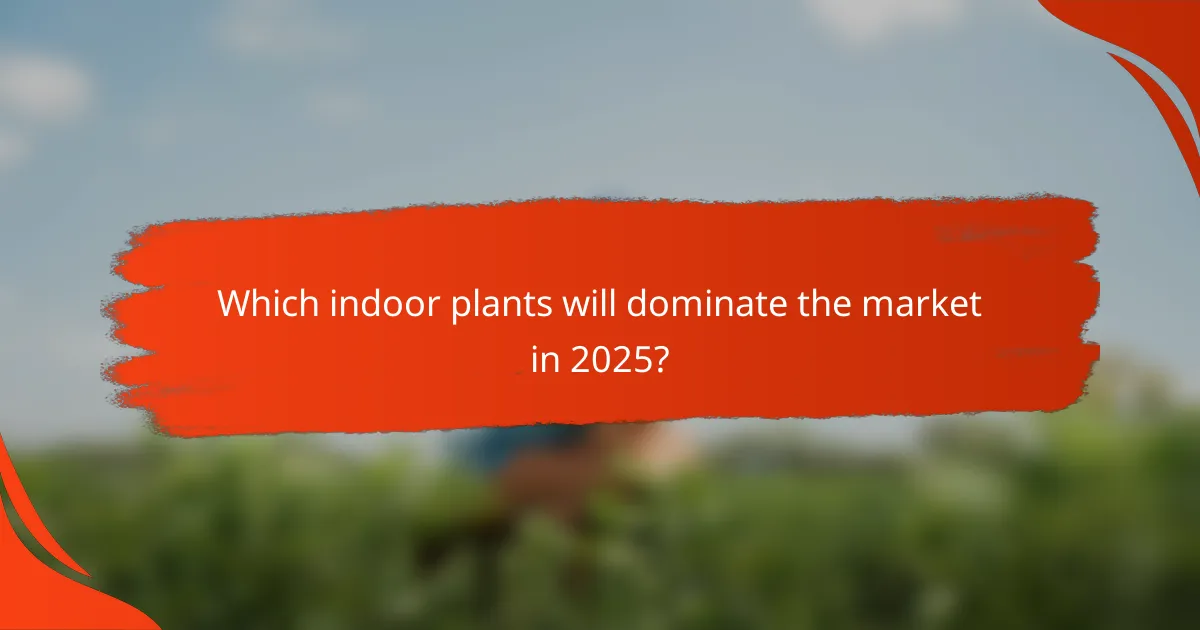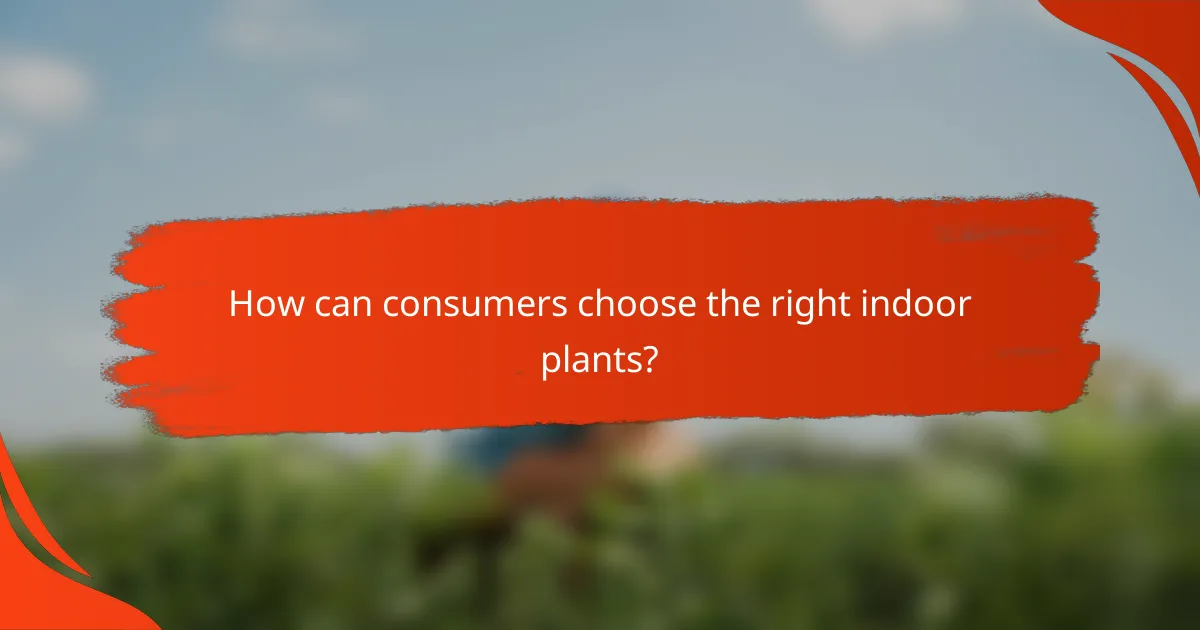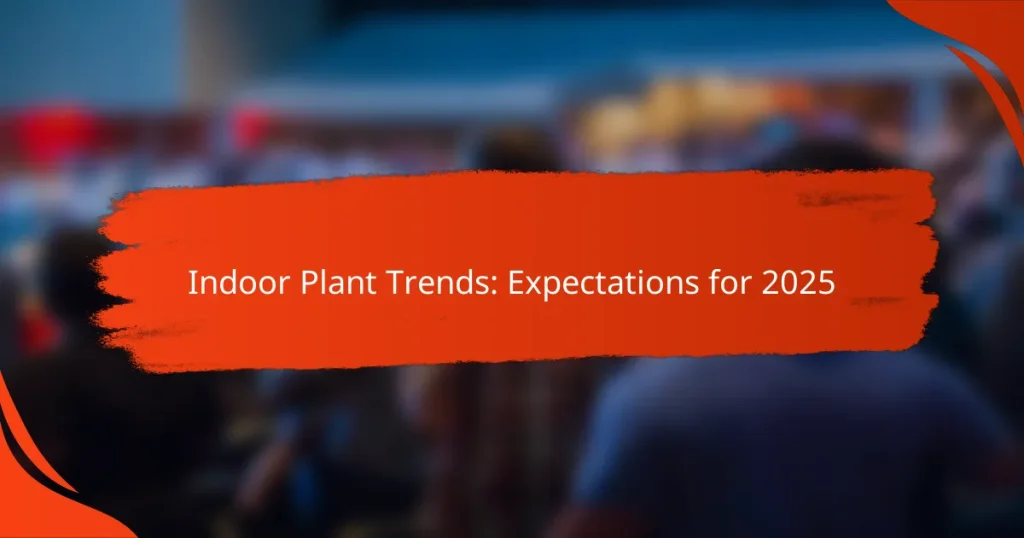As we look ahead to 2025, indoor plant trends are set to evolve, focusing on unique varieties, sustainability, and the integration of technology. With an increasing awareness of mental health benefits and urbanization limiting outdoor gardening space, enthusiasts will embrace innovative solutions that enhance plant care and aesthetics. Subscription services and automated systems will further transform how individuals engage with their indoor gardens, reflecting a commitment to both beauty and environmental responsibility.

What indoor plant trends are expected in 2025?
In 2025, indoor plant trends will likely emphasize unique plant varieties, sustainability, technology integration, urban gardening, and subscription services. These trends reflect a growing interest in both aesthetics and environmental responsibility among plant enthusiasts.
Increased popularity of rare houseplants
Rare houseplants are expected to gain significant traction in 2025, driven by collectors and enthusiasts seeking unique additions to their homes. Plants like variegated Monstera or rare Philodendrons can command high prices, often ranging from hundreds to thousands of dollars.
To navigate this trend, consider joining plant communities online or attending local plant fairs where rare varieties are often available. However, be cautious of the market’s speculative nature; ensure you are purchasing from reputable sellers to avoid scams.
Focus on sustainable plant sourcing
As environmental awareness grows, the focus on sustainable plant sourcing will become increasingly important. Consumers will prefer plants that are ethically sourced and grown using eco-friendly practices, which may include organic fertilizers and biodegradable pots.
When shopping for plants, look for certifications or labels indicating sustainable practices. Supporting local nurseries that prioritize sustainability can also contribute positively to your community and reduce carbon footprints associated with transportation.
Integration of smart gardening technology
Smart gardening technology is set to revolutionize indoor plant care in 2025. Devices such as automated watering systems, light sensors, and plant health monitors will help enthusiasts maintain optimal conditions for their plants.
Investing in smart technology can simplify plant care, especially for those with busy lifestyles. However, ensure that the devices you choose are compatible with your plants’ specific needs and consider the initial investment versus long-term benefits.
Growth of urban gardening initiatives
Urban gardening initiatives will continue to flourish as more people seek to incorporate greenery into limited spaces. Community gardens, vertical gardens, and balcony gardening are becoming popular ways to bring nature into urban environments.
Participating in local gardening groups can provide valuable resources and support. Additionally, consider using space-saving planters and vertical systems to maximize your gardening potential in small areas.
Rise of plant subscription services
Plant subscription services are expected to grow in popularity, offering consumers a convenient way to discover new plants regularly. These services typically deliver curated selections of plants and care instructions directly to your door, making it easier to expand your collection.
When choosing a subscription service, look for options that cater to your skill level and preferences. Some services may focus on low-maintenance plants, while others might offer rare or exotic varieties, allowing you to tailor your experience to your gardening style.

How will indoor plant care evolve by 2025?
By 2025, indoor plant care is expected to become more efficient and user-friendly, driven by technology and sustainability. Innovations in automated systems, artificial intelligence, and eco-friendly products will significantly enhance how plant enthusiasts nurture their greenery.
Advancements in automated watering systems
Automated watering systems are set to become more sophisticated, allowing for precise control over moisture levels. These systems will likely feature sensors that monitor soil moisture and adjust watering schedules accordingly, reducing water waste and ensuring optimal plant health.
Homeowners can expect options that integrate with smart home devices, enabling remote management through apps. For example, systems may allow users to set schedules or receive alerts when plants need attention, making plant care more accessible for busy individuals.
Use of AI for plant health monitoring
Artificial intelligence will play a crucial role in monitoring plant health by analyzing data from various sensors. AI-driven applications can identify signs of stress, pests, or diseases early, allowing for timely interventions.
These tools may provide users with personalized care recommendations based on the specific needs of their plants. For instance, an app might suggest adjusting light exposure or changing fertilizer types based on real-time analysis, enhancing the overall success of indoor gardening.
Emergence of eco-friendly fertilizers
The demand for eco-friendly fertilizers is expected to rise as consumers become more environmentally conscious. These fertilizers will likely be made from natural ingredients, reducing chemical runoff and promoting healthier indoor ecosystems.
Home gardeners can look for options that are organic and sustainably sourced, which not only nourish plants but also support soil health. Products that are certified organic may become more prevalent, making it easier for consumers to make responsible choices for their indoor gardens.

What are the key factors driving indoor plant trends?
Key factors driving indoor plant trends include a growing awareness of mental health benefits, urbanization leading to limited outdoor space, and the influence of social media on plant aesthetics. These elements shape consumer preferences and purchasing behaviors in the indoor gardening market.
Increased consumer awareness of mental health benefits
More people are recognizing the positive impact of indoor plants on mental well-being. Studies suggest that having plants indoors can reduce stress, improve mood, and enhance overall productivity. As awareness spreads, consumers are increasingly seeking out plants that contribute to a healthier living environment.
To capitalize on this trend, retailers can highlight the mental health benefits of specific plants, such as snake plants or peace lilies, which are known for their air-purifying qualities. Providing educational materials on plant care and benefits can also enhance consumer engagement.
Urbanization and limited outdoor space
As urban areas expand, many individuals find themselves with limited outdoor space for gardening. This shift has led to a surge in demand for indoor plants that can thrive in smaller environments, such as apartments or compact homes. Consumers are looking for plants that are easy to care for and can fit into their lifestyle.
Consider offering a variety of low-maintenance plants like pothos or ZZ plants, which are well-suited for indoor living. Providing guidance on vertical gardening or using plant stands can help maximize space and appeal to urban dwellers.
Social media influence on plant aesthetics
Social media platforms have become powerful tools for showcasing plant aesthetics, influencing consumer choices and trends. Instagram and TikTok, in particular, feature visually appealing plant displays that inspire users to curate their own indoor jungles. This trend encourages consumers to invest in unique and trendy plant varieties.
Retailers can leverage this influence by creating visually engaging displays and promoting plants that are popular on social media. Collaborating with influencers in the plant community can also enhance visibility and attract a wider audience.

Which indoor plants will dominate the market in 2025?
In 2025, the indoor plant market is expected to be led by a few standout species known for their aesthetic appeal and ease of care. Key contenders include the Monstera Deliciosa, Philodendron Pink Princess, and various Pothos varieties, each offering unique attributes that cater to diverse consumer preferences.
Monstera Deliciosa
The Monstera Deliciosa, often referred to as the Swiss cheese plant, will continue to be a favorite due to its striking foliage and ability to thrive in various indoor conditions. Its large, perforated leaves can grow up to 3 feet long, making it a dramatic addition to any space.
When caring for Monstera, ensure it receives bright, indirect light and water it when the top inch of soil feels dry. This plant can grow quite large, so consider its space requirements before purchasing.
Philodendron Pink Princess
The Philodendron Pink Princess is gaining popularity for its unique variegated leaves that feature striking pink hues. This plant not only adds a splash of color but is also relatively easy to care for, making it ideal for both novice and experienced plant enthusiasts.
To keep a Pink Princess healthy, provide it with bright, indirect light and maintain humidity levels around 50-60%. Regularly check for pests, as they can be attracted to the plant’s vibrant foliage.
Pothos varieties
Pothos varieties, including Golden Pothos and Marble Queen, are expected to remain staples in indoor gardening due to their adaptability and low maintenance needs. These plants are known for their trailing vines and heart-shaped leaves, which can enhance any indoor environment.
For optimal growth, place Pothos in moderate to bright indirect light and allow the soil to dry out between waterings. They are resilient and can tolerate a range of conditions, making them perfect for busy lifestyles.

How can consumers choose the right indoor plants?
Consumers can choose the right indoor plants by assessing their environment, understanding care requirements, and evaluating their personal lifestyle. Selecting plants that thrive in specific light and humidity conditions while fitting into one’s daily routine is essential for successful indoor gardening.
Assessing light and humidity conditions
Light and humidity are critical factors in selecting indoor plants. Most plants require bright, indirect light, while others thrive in low-light conditions. To determine your space’s light levels, observe how much natural light enters throughout the day and consider using a light meter for accuracy.
Humidity levels can vary significantly depending on the location within a home. Areas like bathrooms and kitchens often have higher humidity, making them suitable for tropical plants. Conversely, dry environments may require plants that tolerate lower humidity or additional humidity sources like misting or humidifiers.
Understanding plant care requirements
Each plant has unique care requirements, including watering frequency, soil type, and fertilization needs. Researching these needs helps ensure that the chosen plants can thrive in your home. For example, succulents generally need less water compared to ferns, which may require consistently moist soil.
Consider creating a care schedule or checklist to keep track of watering and feeding routines. This can help avoid over or under-watering, which are common pitfalls for indoor gardeners.
Evaluating personal lifestyle and space
Your lifestyle and available space play significant roles in plant selection. If you travel frequently or have a busy schedule, opt for low-maintenance plants such as snake plants or pothos that can tolerate neglect. For those with more time, consider plants that require regular care, like orchids or fiddle leaf figs.
Additionally, assess the physical space where the plants will live. Ensure that the chosen plants fit well in terms of size and aesthetics. Using vertical planters or shelves can maximize space and create an appealing display.


